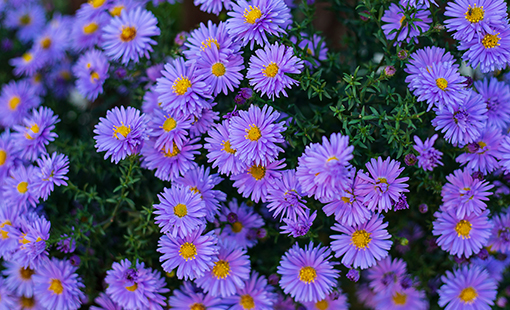
Aster Plant Care & Info
It’s a cruel trick of Mother Nature that that most glorious weather of the gardening season coincides with the decline of most blooming plants. Asters, however, don’t play along with the prank. Like garden mums, asters flower in response to the shortening days of fall, giving gardeners a beautiful display of buds that can bloom from August through October. Native to North America, asters comprise many species in several different genera of plants, as well as dozens of cultivars, but for gardeners, asters are simply great flowers that provide purple or blue daisy-like flowers late in the season.
Although home and garden centers often market asters as a seasonal purchase among displays of pumpkins and hay bales, asters are long-lived perennials that can become a permanent part of your landscape. Though aster flowers have that wildflower look, they are also beautiful in cut-flower arrangements. People aren’t the only ones who find asters attractive—pollinators such as bees and butterflies also love aster flowers. If planted in the fall, they can be a rare source of late-season nectar, making them a crucial flower for pollinators.
Asters can be planted almost any time of the year, though spring is typical since that’s when potted nursery plants are readily available. These fast-growing perennials will be ready to put on a good fall display in their first year, and once established, they will hold their own for many years.
Care
While you can grow aster flowers from seeds planted in the springtime, it may take several years for them to mature into full-sized plants. More often, asters are planted from potted nursery specimens. They do best in loamy, well-draining soil, and desire a good amount of space around the plants to allow space for their roots to expand.
Every three years or so, the root clumps should be dug up and divided to keep the plants from getting too woody and dying out in the centers. The woody center can be discarded, with the outer portions replanted.
When frost finally kills off the foliage, clip off the stems at ground level. This can also be done in the spring to allow birds to feed on the flower seeds throughout winter—both finches and chickadees are especially fond of aster seeds.
Light
Plant our aster flowers in an area that boasts full sun for the majority of the day. Too much shade can cause lanky plants and fewer flowers, especially for the more common cultivars and hybrids. There are some native species varieties, however, that will do quite well in partially shady conditions.
Soil
Asters appreciate loamy soil that’s slightly acidic, with a pH ranging from 5.8 to 6.5. If your soil is alkaline, you can correct it by adding organic matter such as well-rotted manure, leaf mold or compost.
Water
Keep new plantings moist and continue watering regularly until the flowers are finished blooming. As a rule of thumb, the soil your asters reside in should stay consistently moist but never saturated. One thing to note: Try to water the base of your asters without splashing water on the leaves—doing so can cause mildew or fungal growth. One inch of rain or watering once a week is usually recommended for most perennial plants.
Temperature & Humidity
Aster flowers thrive in cooler temperatures and are frost hardy, able to withstand near-freezing temperatures temporarily. When it comes to humidity, asters have no special preferences and therefore will not need increased humidity levels or extra spritzing.
Fertilizer
Asters are moderate feeders, and they appreciate being fed with a balanced flower fertilizer twice a month, beginning in spring and continuing until the blooms begin to open. Excessive nutrients can shorten the blooming time, so stop fertilizing asters in August.
Common Pests & Diseases
Rust and powdery mildew disease can affect aster foliage. Follow proper plant spacing recommendations to improve air circulation, and avoid splashing watering to prevent these problems.
Most insect pests leave asters alone, but lace bugs can be a bother. You’re more likely to notice the damage they cause than the insects themselves, which are very small and a nondescript grayish-brown color. If you spot yellowing foliage and leaf drop in the summer, consider using insect soap on the plants, coating all sides of the foliage to impact the hiding pests. Fortunately, lace bug outbreaks precede aster blooming time, so spraying won’t affect butterflies and bees.
Information courtesy of TheSpruce.com

 Adams Fairacre Farms
Adams Fairacre Farms